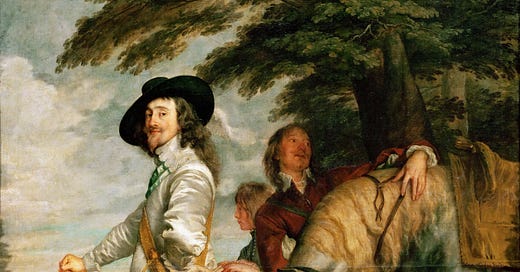Charles I at the Hunt - Anthony van Dyck
About the elegant authority of a king painted in an innovative way.
Anthony van Dyck’s (1599 - 1641) ‘Charles I at the Hunt’ is a painting that radiates royal sophistication without the usual display of monarchical power. Currently housed in the Louvre Museum, this portrait presents King Charles I of England as a figure of duality - an aristocratic gentleman and a sovereign ruler. A format that redefined royal imagery with its innovative blend of formality and grace.
Composition
The king stands in the center, dismounted from his horse, which is relegated to the shadows along with his attendants. This arrangement emphasizes Charles's authority as well as his presence: Van Dyck uses a low-angle perspective to make the king appear taller as he really is (163 cm), and more commanding.
The background includes an idyllic countryside, with a possible view of the Solent with the Isle of Wight. This subtle inclusion reinforces the idea of Charles’s sovereignty over the land.
Draped in refined civilian attire - a shimmering satin doublet, crimson breeches, leather boots, and a cavalier hat - Charles I exudes sophistication. Notably, his confident pose, with one hand on a cane and the other holding gloves, replaces traditional symbols of monarchy like the crown or scepter, signaling an approachable yet authoritative ruler.
The portrait demonstrates Van Dyck’s mastery of naturalism, presenting Charles with what contemporaries described as "instinctive sovereignty." The influence of Venetian artists, particularly Titian, is evident in the interplay of light, rich color, and balanced composition.
Significance
Van Dyck’s portrayal of Charles in a hunting scene is as much propaganda as it is art. The horse’s bowed head hints at submission, symbolizing the king's domination over both man and nature. This relaxed setting projects Charles as a ruler in control, yet one who is relatable to his subjects.
A Latin inscription on a rock subtly asserts his title as "King of Great Britain," emphasizing his political power. The fusion of informal grace with inherent authority made this portrait a benchmark in royal portraiture, influencing depictions of monarchs for generations.
Historical Context
Van Dyck created this work during his tenure as Principal Painter to Charles I, who was an ardent patron of the arts. The king used portraits like this to reinforce his image as a cultured, divinely ordained ruler.
Charles I's passion for art profoundly impacted his reign, somehow contributing to his downfall. His obsession with acquiring masterpieces led to enormous expenditures. The purchase of the collection of Duke of Mantua in 1627 (including works from Titian, Raphael, Caravaggio…) took him two years to pay off, placing a significant burden on the royal treasury.
Charles I's artistic pursuits, while culturally significant, ultimately exacerbated political tensions and financial difficulties that plagued his reign, contributing to the events that led to the English Civil War (starting 1642) and his eventual execution in 1649.
Yet, works like Charles I at the Hunt immortalize the image he wished to convey: a ruler of refinement, intellect, and power.
Today the masterpiece remains a timeless example of how art can craft and project identity. It challenges viewers to consider the power of imagery in shaping perceptions of leadership - a theme as relevant today as it was in the 17th century.





